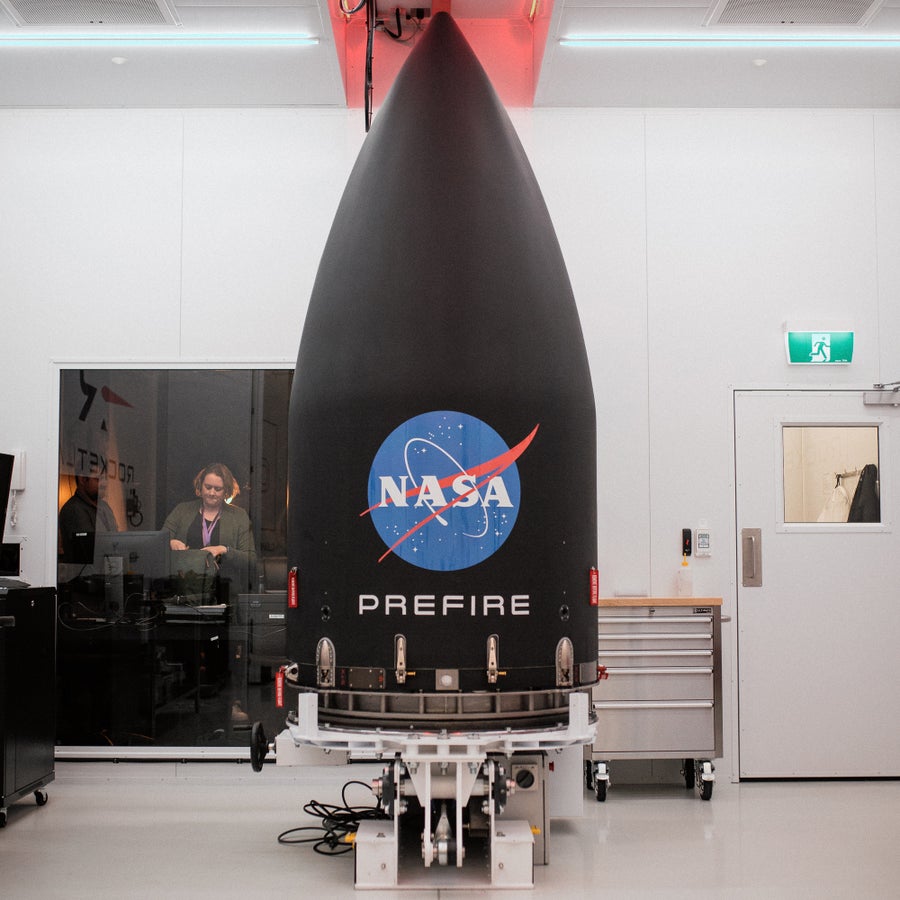The weather was mild on the evening of May 25 at the southern tip of the Māhia Peninsula in New Zealand. The wind was gentle, the sky was clear, and even conditions in the Earth’s upper atmosphere were calm. It was, in every way, a promising night for a rocket launch. And at 7:41 P.M. local time that promise was fulfilled when an Electron booster from the space technology company Rocket Lab lifted off from the company’s launch site and carried a shoebox-sized infrared NASA satellite into a near-polar orbit around Earth.
The Electron launch was the first of two that Rocket Lab completed within less than two weeks for NASA’s Polar Radiant Energy in the Far-InfraRed Experiment (PREFIRE), a 10-month mission to measure how much heat emanates into space from Antarctica and the Arctic. The satellites’ data will help inform models projecting the magnitude of one of climate change’s most frightening effects—the melting of polar ice sheets and the resulting sea-level rise. The mission, like Rocket Lab itself, is meant to punch well above its weight and is emblematic of the company’s plans for blending high-impact science with efficient and accessible space travel and manufacturing, says Rocket Lab’s founder and chief executive officer Peter Beck.
Rockets and space travel are carbon-intensive: a single launch can emit hundreds of tons of greenhouse gases. But Beck says that shouldn’t preclude space companies acting sustainably and serving worthy climate causes—while also expanding access to low-Earth orbit and beyond. Rocket Lab’s Electron, for example, is the only small orbital launch vehicle in the world that is largely reusable, thanks to a parachute system that carries the booster’s engine-packed bottom stage back down to Earth. That reusability limits Electron’s waste and keeps its launches relatively cheap, making space-based research more affordable for smaller organizations and educational institutions.
On supporting science journalism
If you’re enjoying this article, consider supporting our award-winning journalism by subscribing. By purchasing a subscription you are helping to ensure the future of impactful stories about the discoveries and ideas shaping our world today.
During a conversation with Scientific American, Beck discussed PREFIRE and how Rocket Lab and other companies can responsibly navigate the increasingly competitive commercial space industry and support climate science.
[An edited transcript of the interview follows.]
Rocket Lab describes itself as an end-to-end company. What does this mean in the aerospace industry?
End-to-end means that we have the capacity to design the satellite and all its components; build it, test it, then launch it on one of our own rockets; and, once it’s finally in orbit, operate it for an organization or other commercial entity down here on Earth. Sometimes we even get to design the satellite’s mission. We’re basically running everything from one end of the spectrum to the other. Typically the space industry is bifurcated into “launch” and “satellites,” and there are few companies in the world—or even in the history of the space industry—with the capability to do both. For PREFIRE specifically, our job is only to launch the NASA spacecrafts into orbit. But we do have the ability to perform every step of the process for other missions.

Technicians integrate NASA’s PREFIRE (Polar Radiant Energy in the Far-InfraRed Experiment) payload inside the Rocket Lab Electron rocket payload fairing on Wednesday, May 15, 2024, at the company’s facility in New Zealand.
You’ve previously said that one of Rocket Lab’s primary goals is to help “democratize space.” What does this mean to you?
When I started the company in 2006, [space travel and technology] was pretty much the domain of the government. You know, there was SpaceX and a few other small commercial companies that started around the same time as we did. But it was very much dominated by large government institutions, and any commercial enterprise in space was very fringe. Throughout the length of my career, though, I’ve started to witness the growing, vast democratization of space. Most of the launch vehicles in the U.S. are commercially owned now. Rocket Lab has the second most frequently launched rocket in the U.S. And the most frequently launched rocket in the U.S., SpaceX’s Falcon 9, is of course also from a commercial company.
How does space technology help inform experts about climate change?
Satellites and other space technology have been the backbone of climate modeling and understanding for decades. I can even remember watching TV when I was young and, you know, someone onscreen would go, “And now we cut to satellite imagery,” and it would show all this cloud coverage and Earth and whatnot. This was back in the 1980s. So it’s been a cornerstone of climate predictions, and PREFIRE is a good example of this. It’s a mission to really understand rising sea levels and melting ice sheets in the Arctic and Antarctic. The satellites have infrared sensors that can track heat loss, which ultimately indicates how much ice has melted and is lost to the ocean. This information really refines models and helps provide more accurate sea-level-rise predictions.
The unique thing is that in order for these satellites to provide the level of accuracy, resolution and precise measurements that [climate scientists] need, we need to launch the two of them into somewhat different orbits. This is where Electron as a small, reusable rocket really comes into its own. Normally if you wanted to send spacecraft into two separate orbits, you’d also need two separate rockets. You’d have to typically procure a $60-million rocket, making the launches around $120 million total. And these satellites are, you know, about the size of a shoebox. It’d be very difficult to justify that kind of expenditure and resources for such small spacecraft.
Manufacturing space technology and launching rockets requires a lot of greenhouse gas emissions. Is it a good thing for the climate if more organizations can start accessing space?
I think that you have to just put it into context. To get these two satellites into orbit, we used about the same amount of jet fuel as one Boeing 737 flight from Los Angeles to San Francisco. So for that exchange of carbon, which is pretty tiny in the grand scheme of things, we get pretty large science. The fact of the matter is that when you go to space, you have to burn stuff. But it’s burned at such high pressures and temperatures that the combustion products are very efficient. Unfortunately, you can’t do anything in space without some kind of emissions, and so you have to make those trades. Fortunately, with space travel, usually the missions that you’re doing and the services that you’re providing outweigh the cost significantly. I tend to think that putting stuff in space is like building infrastructure. If we put a satellite into orbit to do weather prediction, for example, that small machine provides weather details and data to literally millions of people around the planet. So you can have a really big impact for a relatively small piece of infrastructure. Whereas if you build a road in a city, it’s only the people who live in that area and have access to it who benefit.
How does Rocket Lab try to limit its production of space junk?
It’s a real challenge. Everything that goes into orbit generally leaves some kind of debris behind. And it’s a bit of a misnomer that all the debris in orbit are considered spacecraft when, actually, there’s a large portion of those debris that is, in fact, old, spent rocket pieces. So when we developed Electron we were determined to do our very best to avoid that kind of debris being left behind wherever possible. Fortunately space is very big, but it’s going to get only busier in orbit, and the result of spacecrafts colliding is pretty significant. It’s difficult to get governments together to agree on a set of rules about anything, but I do really think that there needs to be some form of cohesive space traffic management.
As the space travel and technology sector “democratizes,” it also becomes more competitive. Do you think that this high level of competition is “good” for science?
Absolutely. Prior to Electron, you would’ve had to procure a Minotaur or Pegasus rocket—the only small, dedicated launch vehicles available at the time—for somewhere between $35 million and $50 million. The sticker price of an Electron launch is $7.5 million. That’s competition for you. Those two other vehicles are now largely extinct since Electron’s creation, but it’s a great example of how competition has really enabled many more missions. Take our CAPSTONE [Cislunar Autonomous Positioning System Technology Operations and Navigation Experiment] project with NASA from two years ago as an example. That was a $10-million [launch] to the moon. That’s crazy! So, yeah, competition is great.
How would you like to see Rocket Lab evolve over the next several years?
The ultimate goal for us is to become the end-to-end space company that makes space far more accessible and that makes these kinds of climate change missions even more feasible. At the moment the space industry is still very bifurcated. You have to be an expert in spacecraft and know all these things about space to be able to provide a service on Earth. But consolidating that into a single company that researchers, commercial customers and governments can just go to and ask for missions is the idea. I think that’s what large, successful space companies of the future are going to look like. That’s how we make these missions frequent, accessible and affordable.






